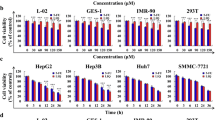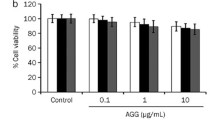Abstract
The root of Actinidia chinensis, as traditional Chinese medicine, has been shown to inhibit cell proliferation in numerous cancer cells. However, the mechanisms underlying its inhibitory activity remain unclear. Death rates of hepatocellular carcinoma (HCC) are increasing, but therapies for advanced HCC are not well developed. We choose the extract from root of Actinidia chinensis (ERAC) to treat the HCC cell lines in vitro, displaying distinct effects on cell proliferation, S-phase cell cycle arrest, and apoptosis. LAMB3, the gene encoding laminin subunit beta-3, plays a key role in the proliferation suppression and S-phase cell cycle arrest of HepG2 cells treated with ERAC. The downstream genes ITGA3, CCND2, and TP53 in LAMB3 pathway show the same response to ERAC as LAMB3. Thus, LAMB3 pathways, along with extracellular matrix-receptor interaction, pathways in cancer, and focal adhesion, are involved in the ERAC-induced suppressive response in HepG2.







Similar content being viewed by others
References
Chung H, Suh EK, Han IO, & Oh ES. Keratinocyte-derived laminin-332 promotes adhesion and migration in melanocytes and melanoma. J Biol Chem, 2011;286:13438-47.
De Lope CR, Tremosini S, Forner A, Reig M, Bruix J. Management of HCC. J Hepatol. 2012;56(Suppl 1):S75–87.
Farhy C, Elgart M, Shapira Z, Oron-Karni V, Yaron O, Menuchin Y, et al. Pax6 is required for normal cell-cycle exit and the differentiation kinetics of retinal progenitor cells. PLoS One. 2013;8:e76489.
Forner A, Llovet JM, Bruix J. Hepatocellular carcinoma. Lancet. 2012;379:1245–55.
Gong Y. Identifying the targets for treatment of liver fibrosis and hepatocellular carcinoma from both Western medicine and Chinese medicine. Chin J Integr Med. 2012;18:245–9.
Gu S, Li G, Zhang X, Yan J, Gao J, An X, et al. Aberrant expression of long noncoding RNAs in chronic thromboembolic pulmonary hypertension. Mol Med Rep. 2015;11:2631–43.
Guha G, Lu W, Li S, Liang X, Kulesz-Martin MF, Mahmud T, et al. Novel pactamycin analogs induce p53 dependent cell-cycle arrest at S-phase in human head and neck squamous cell carcinoma (HNSCC) cells. PLoS One. 2015;10:e0125322.
Gustafsson M, Nestor CE, Zhang H, Barabasi AL, Baranzini S, Brunak S, et al. Modules, networks and systems medicine for understanding disease and aiding diagnosis. Genome Med. 2014;6:82.
Hubbi ME, Gilkes DM, Hu H, Kshitiz, Ahmed I, Semenza GL. Cyclin-dependent kinases regulate lysosomal degradation of hypoxia-inducible factor 1alpha to promote cell-cycle progression. Proc Natl Acad Sci U S A. 2014;111:E3325–34.
Huo J, Qin F, Cai X, Ju J, Hu C, Wang Z, et al. Chinese medicine formula “Weikang Keli” induces autophagic cell death on human gastric cancer cell line SGC-7901. Phytomedicine. 2013;20:159–65.
Ibragimova I, Ibanez DE Caceres I, Hoffman AM, Potapova A, Dulaimi E, Al-Saleem T, et al. Global reactivation of epigenetically silenced genes in prostate cancer. Cancer Prev Res (Phila). 2010;3:1084–92.
Kishimoto K, Fujimoto J, Takeuchi M, Yamamoto H, Ueki T, Okamoto E. Telomerase activity in hepatocellular carcinoma and adjacent liver tissues. J Surg Oncol. 1998;69:119–24.
Lee YS, Ryu SW, Bae SJ, Park TH, Kwon K, Noh YH, et al. Cross-platform meta-analysis of multiple gene expression profiles identifies novel expression signatures in acquired anthracycline-resistant breast cancer. Oncol Rep. 2015;33:1985–93.
Lin HY, Kuo YC, Weng YI, Lai IL, Huang TH, Lin SP, et al. Activation of silenced tumor suppressor genes in prostate cancer cells by a novel energy restriction-mimetic agent. Prostate. 2012;72:1767–78.
Linzen U, Lilischkis R, Pandithage R, Schilling B, Ullius A, Luscher-Firzlaff J, et al. ING5 is phosphorylated by CDK2 and controls cell proliferation independently of p53. PLoS One. 2015;10:e0123736.
Liu T, Zhang S, Chen J, Jiang K, Zhang Q, Guo K, et al. The transcriptional profiling of glycogenes associated with hepatocellular carcinoma metastasis. PLoS One. 2014;9:e107941.
Lou L, Lu D, Hu Z, Hu Z, Zheng F. Anti-tumor activity of Actinidia chinensis Planch against hepatocellular carcinoma. Chin Arch Tradit Chin Med. 2009;27:1509–11.
MONTASERI S, ZARE-MIRAKABAD F, MOGHADAM-CHARKARI N. RNA-RNA interaction prediction using genetic algorithm. Algorithms Mol Biol. 2014;9:17.
Song WY, Xu GH, Zhang GJ. Effect of Actinidia chinensis planch polysaccharide on the growth and apoptosis, and p-p38 expression in human gastric cancer SGC-7901 cells. Zhongguo Zhong Xi Yi Jie He Za Zhi. 2014;34:329–33.
Tarocchi M, Polvani S, Peired AJ, Marroncini G, Calamante M, Ceni E, et al. Telomerase activated thymidine analogue pro-drug is a new molecule targeting hepatocellular carcinoma. J Hepatol. 2014;61:1064–72.
Tripathi M, Nandana S, Yamashita H, Ganesan R, Kirchhofer D, & Quaranta V. Laminin-332 is a substrate for hepsin, a protease associated with prostate cancer progression. J Biol Chem, 2008;283:30576–84.
Walz C, Crowley BJ, Hudon HE, Gramlich JL, Neuberg DS, Podar K, et al. Activated Jak2 with the V617F point mutation promotes G1/S phase transition. J Biol Chem. 2006;281:18177–83.
Wang CJ, Xiao CW, You TG, Zheng YX, Gao W, Zhou ZQ, et al. Interferon-alpha enhances antitumor activities of oncolytic adenovirus-mediated IL-24 expression in hepatocellular carcinoma. Mol Cancer. 2012;11:31.
Wang XM, Li J, Yan MX, Liu L, Jia DS, Geng Q, et al. Integrative analyses identify osteopontin, LAMB3 and ITGB1 as critical pro-metastatic genes for lung cancer. PLoS One, 2013;8:e55714.
Wang K, Liang C, Liu J, Xiao H, Huang S, Xu J, et al. Prediction of piRNAs using transposon interaction and a support vector machine. BMC Bioinformatics. 2014;15:6593.
Young AL, Bailey EE, Colaco SM, Engler DE, & Grossman ME. Anti-laminin-332 mucous membrane pemphigoid associated with recurrent metastatic prostate carcinoma: hypothesis for a paraneoplastic phenomenon. Eur J Dermatol. 2011;21:401–4.
Zhu AX. New agents on the horizon in hepatocellular carcinoma. Ther Adv Med Oncol. 2013;5:41–50.
Author information
Authors and Affiliations
Corresponding author
Electronic supplementary material
Supplemental Figure 1
A, quality control of microarray experiments. B, the expression profile of genes were shown as 0.2 fold change per box in the screen for ERAC action genes of LM3. C, the expression profile of genes were shown as 0.2 fold change per box in the screen for ERAC action genes of HepG2. (PDF 62.5 kb)
Supplemental Figure 2
LAMB3 involved pathways analyses of ERAC action. A, Quantitation of important laminin isoforms of ERAC action. B, Quantitation of important genes in LAMB3 involved pathways. (PDF 204 kb)
Rights and permissions
About this article
Cite this article
Hou, J., Wang, L. & Wu, D. The root of Actinidia chinensis inhibits hepatocellular carcinomas cells through LAMB3. Cell Biol Toxicol 34, 321–332 (2018). https://doi.org/10.1007/s10565-017-9416-7
Received:
Accepted:
Published:
Issue Date:
DOI: https://doi.org/10.1007/s10565-017-9416-7




